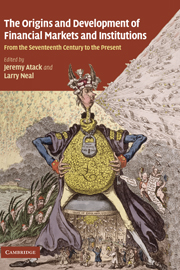 The Origins and Development of Financial Markets and Institutions
The Origins and Development of Financial Markets and Institutions Published online by Cambridge University Press: 04 August 2010
Recent work on the political economy of imperialism emphasizes how the imperial power can transform less-developed economies by setting up institutions that underpin modern financial markets, lower political risk, and benefit both the creditor and debtor nations. Kris Mitchener and Marc Weidenmier, for example, present the Roosevelt Corollary to the Monroe Doctrine (1904) as a natural experiment and demonstrate that Theodore Roosevelt's administration used the Corollary as a credible threat of military intervention that enforced sovereign debt contracts and suppressed political conflict in Central America and the Caribbean. But natural experiments can be misleading: can one generalize from such findings to say that imperial powers set up “rules of the game” that underpin secure property-rights for international capital markets? In reality, the imperial power may choose to enforce or to violate the rules of the game when it is in its interest to do so.
In contrast, there is an extensive literature that declares the evils of imperialism and its US variety to be a source of internal political corruption and economic demoralization. This is a central theme in the historiography of Central America and the Caribbean, but nowhere is it more salient or more symbolic than Cuba, where even those who are critical of the Castro regime often see the anti-imperialism of the Cuban Revolution as justified.
To save this book to your Kindle, first ensure [email protected] is added to your Approved Personal Document E-mail List under your Personal Document Settings on the Manage Your Content and Devices page of your Amazon account. Then enter the ‘name’ part of your Kindle email address below. Find out more about saving to your Kindle.
Note you can select to save to either the @free.kindle.com or @kindle.com variations. ‘@free.kindle.com’ emails are free but can only be saved to your device when it is connected to wi-fi. ‘@kindle.com’ emails can be delivered even when you are not connected to wi-fi, but note that service fees apply.
Find out more about the Kindle Personal Document Service.
To save content items to your account, please confirm that you agree to abide by our usage policies. If this is the first time you use this feature, you will be asked to authorise Cambridge Core to connect with your account. Find out more about saving content to Dropbox.
To save content items to your account, please confirm that you agree to abide by our usage policies. If this is the first time you use this feature, you will be asked to authorise Cambridge Core to connect with your account. Find out more about saving content to Google Drive.